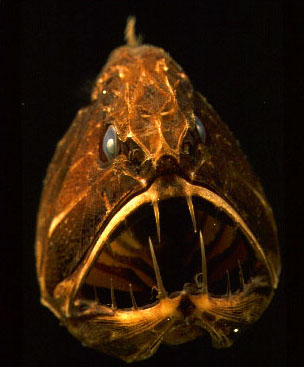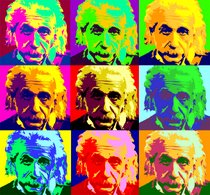Of course, wherever life came from there wouldn’t be much point in being alive if it wasn’t for us.
“That’s a bit dramatic isn’t it Albert?”
I mean us as light coming from a star, rather than you and me. Nearly every living thing on earth depends on the light from its nearest star, the sun. 
“Nearly?”
Well I would have said all life until I read that deep in the oceans there are bacteria that live around vents in the ocean floor where hot volcanic water and gas bubble up. They live off the chemical hydrogen sulphide that comes out of these vents. So they are living off chemical energy not light energy and strange giant worms live off them. Mind you, as hydrogen sulphide has the smell of rotten eggs and is just as poisonous as hydrogen cyanide to most life forms, you can hardly call it living.
“Hold on Albert, the rotten egg smell chemical is also in stink bombs isn’t it? It can’t be that poisonous?”
It really is that poisonous, it’s just that it is so smelly that it only takes a miniscule amount to make a good stink. Even 600 molecules of hydrogen sulphide for every million molecules of air could kill you and at that concentration your sense of smell is paralysed so you can’t even smell it. So all in all I’d rather not live near one of the underwater vents. For all rest of life on earth sunlight is the power source. Plants trap the energy from light and with the gas CO2 from the atmosphere and water make sugars.
"But humans don't eat sunlight."
No, but they do eat plants that grow using the sugars they make out of sunlight. Even pure meat eaters like lions eat other animals, that might eat other animals, that might eat even smaller animals, but at some stage the smallest forms of life are ether green or eat something green.
“How do plants use sunlight if we can’t?” The process that plants use to trap the energy from the sun into a chemical form is called photosynthesis, literally making things (the ‘synthesis’ bit) out of light (the ‘photo’ bit). A special molecule called chlorophyll captures photons and uses the energy to make water and CO2 stick together to make sugars and other more complicated molecules. This pigment is green which is why plants are green. The sugars can be converted into all the other things that plants are made of. In potato plants all the excess sugar that is manufactured in the leaves and other green parts of the potato plant is moved underground and stored as starch.
The process that plants use to trap the energy from the sun into a chemical form is called photosynthesis, literally making things (the ‘synthesis’ bit) out of light (the ‘photo’ bit). A special molecule called chlorophyll captures photons and uses the energy to make water and CO2 stick together to make sugars and other more complicated molecules. This pigment is green which is why plants are green. The sugars can be converted into all the other things that plants are made of. In potato plants all the excess sugar that is manufactured in the leaves and other green parts of the potato plant is moved underground and stored as starch.
“So a potato is like bottled sunshine.”
That’s right and french fries are deep fried sunshine. When you eat a potato, you release the energy trapped in the sugar and turn sugars back into water and carbon dioxide.
"If animals reverse the process that makes sugar by photosynthesis, why don't they glow when they eat vegetables?"
What a great thought, but animals don't exactly reverse photosynthesis. If they did they would have to give back all the energy as light and so wouldn’t be any better off. Instead they have their own specialised pigments that break down sugar back into water and carbon dioxide but trap the released the energy in the form of a chemical called ATP (adenosine triphosphate) which is the energy currency used in cells. This whole process is called metabolism. The idea that animals might glow when eating is not as odd an idea as it seems. Some bacteria and fungi that live by digesting dead plants and animals do actually glow as they eat. Rotting wood or meat infested with certain bugs can give off a faint bluish light.
"What about fireflies, they glow don't they?"
Yes but when they're mating, not when they are eating. Animals like fireflies have evolved such amazing tricks to produce light that it leaves you wondering how evolution alone could have done it. Fireflies mate at night and use flashes of light to attract one another. Each species of firefly has its own code of flashes so that they can avoid an embarrassing meeting in the dark with the wrong sort of firefly.
“So light is important for reproduction too?” Of course, light helps you to find food, avoid predators and to attract or even find a mate. The beautiful plumage of birds is only there to be seen by potential mates. Most humans choose clothes because of how they look in them. If there was no light, evolution wouldn't have evolved eyes and no-one would care what they looked like. So photons drive the entire fashion industry. Of course some animals live where there is no light or very little light and so they have little vision. There’s an old saying ‘beauty is in the eye of the beholder’, and if there is no-one to do the beholding (or seeing) then why should evolution bother to make you beautiful? This is probably why you don't see many beautiful moles, bats or deep sea fishes. But apart from these creatures that live in very dark places, nearly all animals from the very simplest can react to light. Not all can ‘see’ as you might understand it, but even tiny microscopic organisms can detect light and move towards or away from it.
Of course, light helps you to find food, avoid predators and to attract or even find a mate. The beautiful plumage of birds is only there to be seen by potential mates. Most humans choose clothes because of how they look in them. If there was no light, evolution wouldn't have evolved eyes and no-one would care what they looked like. So photons drive the entire fashion industry. Of course some animals live where there is no light or very little light and so they have little vision. There’s an old saying ‘beauty is in the eye of the beholder’, and if there is no-one to do the beholding (or seeing) then why should evolution bother to make you beautiful? This is probably why you don't see many beautiful moles, bats or deep sea fishes. But apart from these creatures that live in very dark places, nearly all animals from the very simplest can react to light. Not all can ‘see’ as you might understand it, but even tiny microscopic organisms can detect light and move towards or away from it.
"So what do you need to be able to see?"
An eye, a brain and a bit of light. A fancy eye is useless if it is attached to a brain the size of a pinhead and any eye is useless if you live somewhere without light. Simple animals only need simple eyes because they are too dumb to need anything better. The simplest eye of all is something that can just tell light from dark, what’s called a light receptor. Next step up is an eye that can tell which direction light is coming from. Simple creatures like flies have compound eyes made up of lots of receptor cells that can tell light from dark. Each receptor points in a different direction so that the pattern of light can be used to see what things are and where they are.
“What about our eyes?”
Human eyes have evolved to a spectacular level of precision. But before you get too proud of your own visual apparatus, you should know that some animals can see things that you can't see. Birds like hawks and eagles can see better than humans. When lunch depends on spotting a mouse while hovering at a hundred feet, good eyesight becomes essential. Lunch for many humans seems to involve reading the label on a sandwich and then guiding it towards the mouth. Not too challenging after all. In many ways it is surprising that humans can see as well as we do. But then, there is more to life than finding the next meal. Seeing better than humans is one thing, but some animals can see the invisible.
“How can you see the invisible? That doesn’t make any sense.”
This might seem impossible until you realise that invisible only means invisible to humans. It's just one of the many perks of being the dominant life form on the planet. You get to name everything and decide what is and isn’t invisible. Bees can see into the ultraviolet spectrum. Ultraviolet is where light gets bluer and bluer and after that seems to disappear. Some flowers, which look boring and white to us, are spectacular in ultraviolet light. Bees might be rather impressed if they knew that humans could ‘see’ red light that was invisible to them. Some snakes, like vipers can see even redder light than humans, what humans call the infrared. This allows vipers to see in the dark. They perform this neat trick with special pits next to their mouths. Handy for vipers, but I don’t suppose the mice they eat are that impressed.
"So are we infrared or ultraviolet or what type of light?"
We’re good old fashioned visible type of light.
“So will we be seen?”
Perhaps, if anyone is looking this way when we finally reach earth in the next few minutes. I guess we’ll just have to wait and see.
Enjoyed it? Then Digg it.
This is the story of a great journey that started with a great thought. One day in 1895 a boy looked into a mirror and wondered what the universe would look like if he could travel on a beam of light. That sixteen year old boy was Albert Einstein and that one thought started him on the road to discover his Theory of Relativity. The great man has been reinvented as Albert 2.0 to come back and blog about a journey through space on a beam of light and explain the science behind everything from atoms, blackholes to global warming. If you've just joined and want to start at the beginning use the index on the left. If you're bored try these links below just for fun.
UNSCRAMBLE EINSTEIN'S BRAIN
PRACTISE SAVING THE WORLD FROM ASTEROIDS
ALIEN CONTACT CALCULATOR
HEAR THE REAL EINSTEIN TALK ABOUT E=Mc2.
Saturday, September 29, 2007
Light of my Life (and almost every other living thing)
Labels: chlorophyll, hydrogen sulphide, Life, photosynthesis
3 Comments:
Subscribe to:
Post Comments (Atom)








if bacteria or something didnt know light existed,
why would they have evolved eyes to start with?